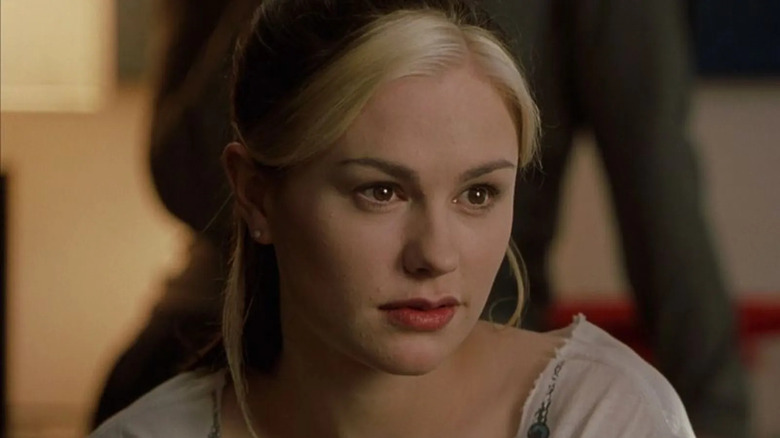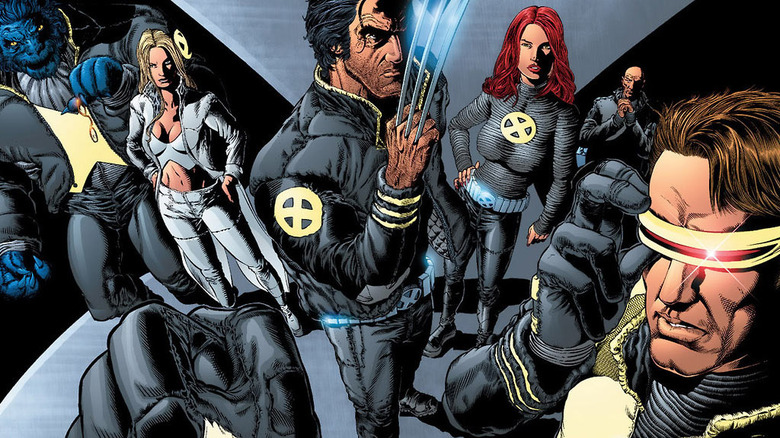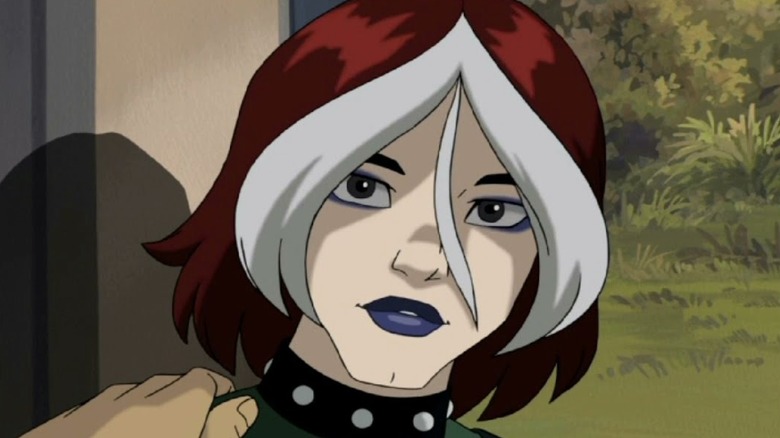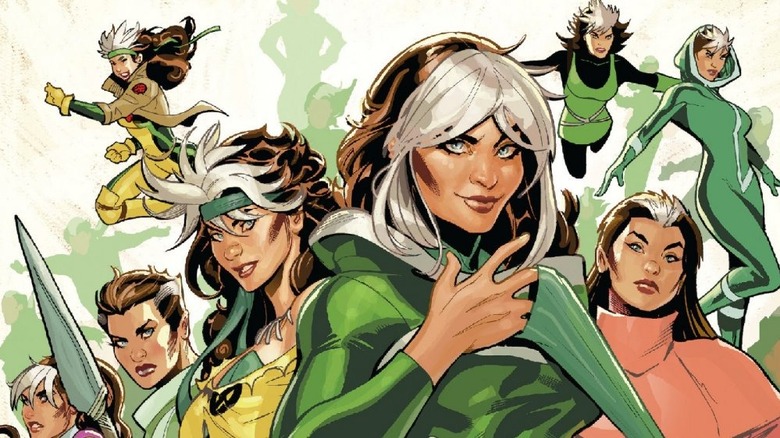The X-Men Movies Almost Changed Rogue In The Comics
For as long as I've known the X-Men, Rogue has been one of my favorite members of the team. It was her white-streaked hair and charming Southern Belle accent that first caught my notice, but what makes Rogue endure is her tortured soul.
Her untamed powers, to lethally absorb the vitality, memories, and superabilities of other people, prevent her from touching anyone; her first kiss put her boyfriend in a coma. So, she keeps herself closed off, too afraid of hurting others to get close to them — even her true love Gambit/Remy LeBeau. With this intersection of superpowers and characterization, Rogue shows how not all mutant powers are blessings. Due to underserved sex education in the United States, plenty of teens (especially queer ones) can relate to Rogue's fear that intimacy will cause calamity.
Now, most "X-Men" characters have complicated histories and Rogue is no different. Writer Chris Claremont may be most famous for "X-Men," but he also wrote "Ms. Marvel" in the 1970s. He created Rogue with artist Michael Golden as a villain for Carol Danvers; in Rogue's debut, "Avengers Annual #10," she's a villain who steals Ms. Marvel's powers. It wasn't long before she joined the heroes, though, in "Uncanny X-Men" #171 (by Chris Claremont and Walt Simonson).
With no real name besides "Rogue," she still became a fan favorite. She was a star in the 1992 "X-Men" cartoon series (voiced by Lenore Zann), the spitting image of the comic version with an ostentatious personality and the Ms. Marvel powers of super-strength and flight. Someone who wasn't a fan? Comic writer Grant Morrison, who almost reworked Rogue from the ground up when writing "X-Men."
Morrison's New X-Men
During Morrison's tenure at Marvel in the early 2000s, their biggest book was "New X-Men," which introduced a new look for the team, new characters, and new mythology. To understand Morrison's "X-Men," you must first understand the decade that led up to it.
The X-Men were on top of the world in the early 1990s. The relaunched "X-Men" issue #1 from 1991 (co-written by Claremont and the issue's artist Jim Lee) is the highest-selling single-issue comic book ever, selling over 8 million copies. Wolverine equaled if not eclipsed Spider-Man as Marvel's flagship character. The X-Men finally getting their own animated show (the aforementioned '92 series) was no doubt a result of their comic success and the cartoon only bolstered the brand.
That's not to say all was right at the House of Ideas. Chris Claremont abruptly departed "X-Men" in 1991 after creative conflicts with Lee and editor Bob Harras, ending his titanic 16-year run. His last credited issue (for the time) was "X-Men" #3. The X-Men were left in the hands of Lee and other new writers/artists, like Rob Liefeld and Scott Lobdell.
The "X-Men" became synonymous with the excesses of 1990s comics, many that linger to this day (constant new issue #1's, variant covers for every issue, disruptive crossover events, etc.) The franchise beget spin-off after spin-off ("X-Force," "Generation X," etc.) and was the centerpiece of the massive "Age of Apocalypse" crossover. With so many comics hitting the shelves, it's no surprise that the bubble eventually burst and Marvel filed for bankruptcy in 1996. One of their strategies out of that hole was selling off the "X-Men" movie rights to 20th Century Fox.
A new kind of Rogue
In the live-action "X-Men" movies, Rogue (played by Anna Paquin), was a shy teenager who absorbed Kitty Pryde's usual role as Wolverine's kid sidekick. Giving the teen X-Man unenviable powers did make some sense (puberty, am I right?). "X-Men: Evolution" went a step further and made Rogue (Meghan Black) into a Goth; she wore a spiked collar, chilly blue lipstick, and concealed her midriff only behind a see-through green veil.
Morrison came to the "X-Men" writing job with a manifesto on how to revitalize the franchise (this was later printed in collected editions of the run). Their central pitch — make the books modern and more reader-friendly — was realized in "New X-Men," but not all the ideas of the manifesto were. One discarded pitch was replacing Rogue. Morrison was taken with how the movies and "Evolution" reinterpreted Rogue, feeling these takes were more cohesive characters than the comic and '92 versions. After laying out their goals and pitching their first arc "E is For Extinction," Morrison mentions plans for Rogue in one of the manifesto's concluding paragraphs:
"I'd like to kill Rogue and replace her later with another Rogue who's more like the Goth-y kid in the movie and the cartoon (the idea that a woman who can't touch anyone safely would have the self-confident, brash personality of a Southern sex bomb was always unconvincing) [...] let's stir up the status quo a little and make things happen."
Morrison also pitches a scene where a grief-stricken Gambit and Wolverine commiserate in a bar over Rogue's death.
Saved by her creator
What's weird is that Morrison wanted not to adjust Rogue's characterization but to wipe her character's slate clean. How would this "new Rogue" have been introduced? Cloning? Time travel? The multiverse? Or maybe it would've just been an entirely separate character with the same look and powers who would adopt the name. Morrison's manifesto stresses appeals to youth culture, which a teen Goth would definitely be.
Rogue was saved by her creator, for Claremont returned to the X-Men around the time Morrison also came on board. Rogue was part of the line-up in Claremont's book, "Extreme X-Men," which saved her from Morrison's chopping block in "New X-Men." Morrison left Marvel in 2004 and never returned, so their Rogue plans remain unrealized. However, later writers did take note of Morrison's advice to disrupt the status quo. In 2009's "X-Men Legacy" issue #224 (written by Mike Carey), she gains control of her powers at last. About a decade later in Kelly Thompson, Oscar Bazaldua, and Javier Pina's "Mr. and Mrs. X," she and Gambit finally tie the knot. With these developments, there's no reason for Rogue to not be "self-confident [and] brash."
Rather than defining the future of the character, Rogue's shy Goth phase became just that — a phase.



